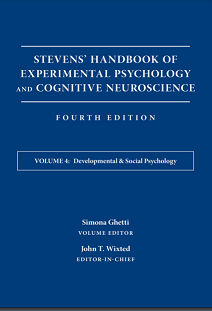
e-BOOK
Stevens Handbook of Experimental Psychologu and Cognitive Neuroscience
Since the first edition was published in 1951, The Stevens’ Handbook of Experimental Psychology has been recognized as the standard reference in the experimental psychology field. The most recent (third) edition of the handbook was published in 2004, and it was a success by any measure. But the field of experimental psychology has changed in dramatic ways since then. Throughout the first three editions of the handbook, the changes in the field were mainly quantitative in nature. That is, the size and scope of the field grew steadily from 1951 to 2004, a trend that was reflected in the growing size of the handbook itself: the one-volume first edition (1951) was succeeded by a two-volume second edition (1988) and then by a four-volume third edition (2004). Since 2004, however, this stillgrowing field has also changed qualitatively in the sense that, in virtually every subdomain of experimental psychology, theories of the mind have evolved to include theories of
the brain. Research methods in experimental psychology have changed accordingly and now include not only venerable EEG recordings (long a staple of research in psycholinguistics) but also MEG, fMRI, TMS, and single-unit recording. The trend toward neuroscience is an absolutely dramatic, worldwide phenomenon that is unlikely ever to be reversed. Thus, the era of purely behavioral experimental psychology is already long
gone, even though not everyone has noticed. Experimental psychology and cognitive neuroscience (an umbrella term that, as used here, includes behavioral neuroscience, social neuroscience, and developmental neuroscience) are now inextricably intertwined. Nearly every major psychology department in the country has added cognitive neuroscientists to its ranks in recent years, and that trend is still growing. A viable handbook of
experimental psychology should reflect the new reality on the ground.
Ketersediaan
| 103 | 150.3 | Website | Tersedia |
Informasi Detail
- Judul Seri
-
-
- No. Panggil
-
150.3
- Penerbit
- Canada. : John Wiley & Sons, Inc., 2018
- Deskripsi Fisik
-
xii, 661 halaman
- Bahasa
-
Inggris
- ISBN/ISSN
-
9781119170051
- Klasifikasi
-
150.3
- Tipe Isi
-
text
- Tipe Media
-
computer
- Tipe Pembawa
-
online resource
- Edisi
-
Edisi 4, Volume 4
- Subjek
- Info Detail Spesifik
-
-
- Pernyataan Tanggungjawab
-
John T. Wixted
Versi lain/terkait
Tidak tersedia versi lain
Lampiran Berkas
Komentar
Anda harus login sebelum memberikan komentar
 Karya Umum
Karya Umum  Filsafat
Filsafat  Agama
Agama  Ilmu-ilmu Sosial
Ilmu-ilmu Sosial  Bahasa
Bahasa  Ilmu-ilmu Murni
Ilmu-ilmu Murni  Ilmu-ilmu Terapan
Ilmu-ilmu Terapan  Kesenian, Hiburan, dan Olahraga
Kesenian, Hiburan, dan Olahraga  Kesusastraan
Kesusastraan  Geografi dan Sejarah
Geografi dan Sejarah